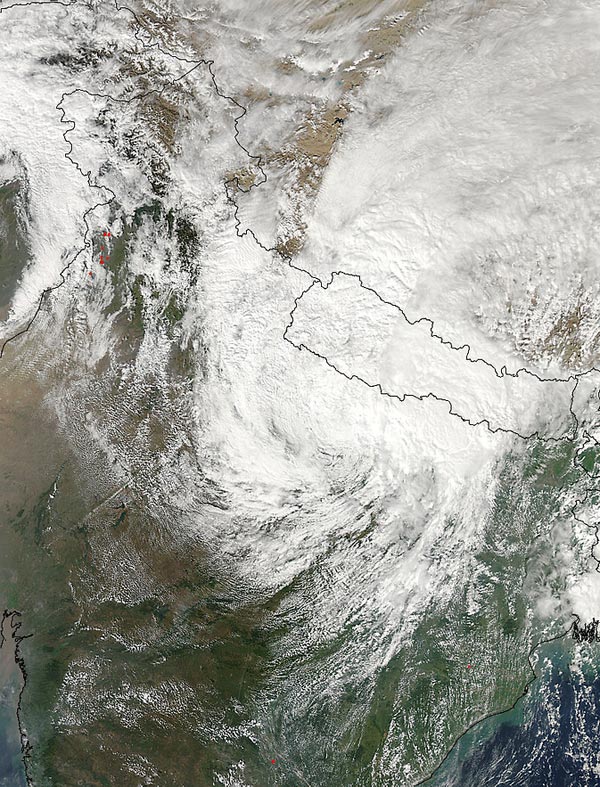NASA Satellite Spots Hudhud's Remnants

NASA's Aqua satellite saw the remnants of Typhoon Hudhud still over India, Nepal, and China on Oct. 14 at 08:05 UTC (4:05 a.m. EDT). Image Credit: NASA Goddard MODIS Rapid Response Team
When NASA's Aqua satellite passed over Indochina, the Moderate Resolution Imaging Spectroradiometer or MODIS instrument provided picture proof that the remnants of Typhoon Hudhud were still over India, Nepal, and China. Aqua passed over the region on Oct. 14 at 08:05 UTC (4:05 a.m. EDT).
Infrared satellite imagery and multispectral satellite imagery indicated that Hudhud made landfall near Visakhapatnam at about 0700 UTC (3 a.m. EDT) Oct. 12. At 11 a.m. EDT, Hudhud was inland and centered near 18.4 north and 82.5 east, about 30 nautical miles west-northwest of Visakhapatnam, Hudhud was moving northwestward at 8 knots and maximum sustained winds were still near 105 knots, making it hurricane-force over land.
Hudhud's hurricane-force winds destroyed the Cyclone Warning Centre. According to Chief Minister N. ChandrababuNaidu, Visakhapatnam and the neighboring districts of Vizianagaram and Srikakulam reported many damages from the storm and some reports indicated over 20 deaths.
Hudhud's remnants are expected to dissipate over land.
Rob Gutro
NASA's Goddard Space Flight Center
Media Contact
More Information:
http://www.nasa.gov/content/goddard/hudhud-northern-indian-ocean/All latest news from the category: Physics and Astronomy
This area deals with the fundamental laws and building blocks of nature and how they interact, the properties and the behavior of matter, and research into space and time and their structures.
innovations-report provides in-depth reports and articles on subjects such as astrophysics, laser technologies, nuclear, quantum, particle and solid-state physics, nanotechnologies, planetary research and findings (Mars, Venus) and developments related to the Hubble Telescope.
Newest articles

A universal framework for spatial biology
SpatialData is a freely accessible tool to unify and integrate data from different omics technologies accounting for spatial information, which can provide holistic insights into health and disease. Biological processes…

How complex biological processes arise
A $20 million grant from the U.S. National Science Foundation (NSF) will support the establishment and operation of the National Synthesis Center for Emergence in the Molecular and Cellular Sciences (NCEMS) at…

Airborne single-photon lidar system achieves high-resolution 3D imaging
Compact, low-power system opens doors for photon-efficient drone and satellite-based environmental monitoring and mapping. Researchers have developed a compact and lightweight single-photon airborne lidar system that can acquire high-resolution 3D…





















